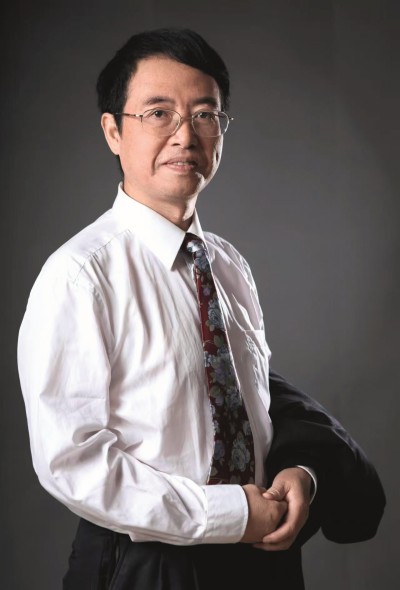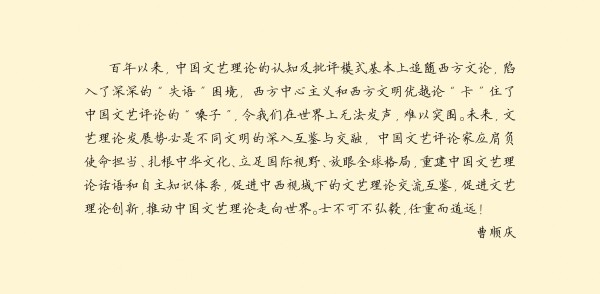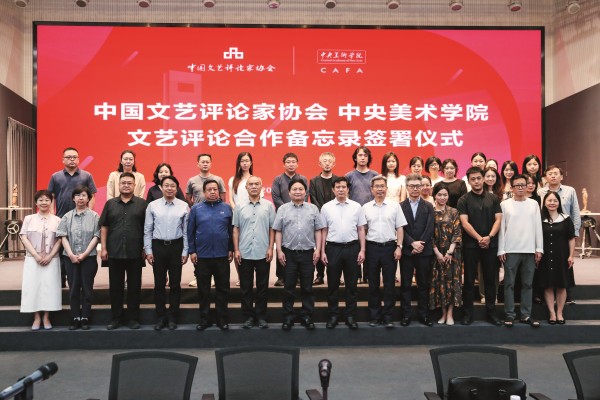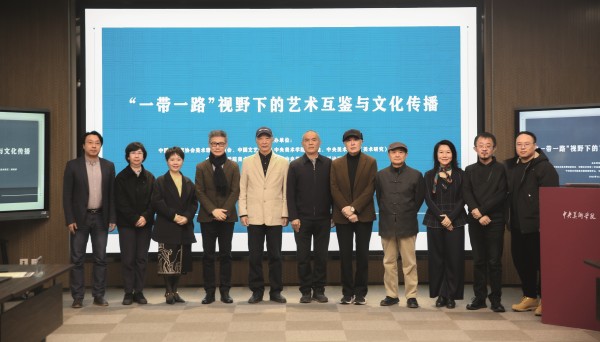
Special Topics •Literary Observations under the Perspective of "Two Combinations"
■ The "Second Combination" to Promote the High-Quality Innovation andDevelopment of Literature and Art in the New Era (PP. 4–12)Lai Daren
Abstract: The modernization and development of Chinese literature and art is the result of the combination of Marxist concepts of literature and art with the practice of Chinese literature and art, as well as with outstanding Chinese literature and art traditions. After the introduction of the Marxist concept of literature and art, it has strongly activated and prompted the transformation of Chinese literature and art traditions into modernity, formed a new form of Chinese Marxist concept of literature and art and played a dominant role in it, thus profoundly influencing the process of modernization of Chinese literature and art and accumulating a rich historical experience of the "Two Combinations". Since the New Era, General Secretary Xi Jinping's important works on the work of literature and art have fully embodied the prominent features and fundamental spirit of the "Two Combinations", especially the "Second Combination", and formulated new requirements for the high-quality innovation and development of literature and art in the New Era. From the new requirements of the "Second Combination" and in relation to contemporary literary phenomenon, there are some issues of integrity and innovation in the development of literature and art that deserve our attention and reflection.
Keywords: "Two Combinations", the "Second Combination", literature and art in the New Era, high-quality development, integrity and innovation
■ Practical Wisdom: The Hub between Marxist Aesthetics and Traditional Chinese Aesthetics (PP. 13–23)Song Wei
Abstract: Xi Jinping, General Secretary of the CPC Central Committee, highly generalizes and summarizes the "Two Combinations", and at the same time, he especially clarifies the importance and significance of the "Second Combination": the Combination of Marxism with fine traditional Chinese culture. The aesthetic dimension of art is the proper meaning of our understanding of the "Second Combination". Practical wisdom is the core category, the key hub and the joint point of combining the basic principles of Marxism with fine traditional Chinese culture. Marxist aesthetics and traditional Chinese aesthetics share a distinctive practical character or conduct, and both pay attention to the aesthetic problems closely related to the practice of human life, such as art and life, art and society, art and ethics, and art and freedom. Therefore, both can be identified as coherent practical aesthetics or the aesthetics of "unity of knowledge and practice" with "practical wisdom" as substance and function. This article takes the practical wisdom of "unity of knowledge and practice" as the key hub, connects the intertextual dialogue and organic integration between Marxist aesthetics and traditional Chinese aesthetics, in order to provide a philosophical vision, humanistic dimension and practical wisdom for the Sinicization of Marxist aesthetics and art theory.
Keywords: practical wisdom, the unity of knowledge and practice, Marxist aesthetics, traditional Chinese aesthetics, the "Second Combination"
■ The "Departure" and the "Restart" of the Aesthetic of Literature and Art Following the Guidance of "Two Combinations" (PP.24–35)Li Yongxin
Abstract: The modern transformation of classical Chinese aesthetics from the Marxist point of view is the original intention of Hu Jingzhi who proposed the aesthetic of literature and art, and it is the important way to combine Marxist theory with China's outstanding traditional culture in aesthetics. Following the guidance of "Two Combinations", the aesthetic of literature and art actively absorbs the latest of Marxist theory, upholds the cultural characteristics of the Chinese nation and the outstanding characteristics of Chinese civilization, highlights the unique characteristics of classical Chinese aesthetics, which attaches importance to the aesthetic experience and abstracts and generalizes it. The "departure" of the aesthetic of literature and art means that it keeps its radar tuned to reality from the Marxist point of view, and strives to interpret and reconstruct the aesthetic category full of vitality in classical Chinese aesthetics. And furthermore, the "restart" of the aesthetic of literature and art suggests: on the one hand, the material media of literature and art should be focused on, in which the law of uniformity of specific works of art and art categories should be conceived in the study of the cross media nature of different types of arts and the relationship between them. And on the other hand, literature and art should be thought of as signifying practices, in which the complex relations between art (including literature) and history should be revealed from the national characteristics of Chinese, which will improve the developments of "Chinese literature", "Chinese poetics" and "Chinese aesthetics".
Keywords: "Two Combinations", the aesthetic of literature and art, Marxism, classical Chinese aesthetics, signifying practices
■ Research on the Creation of Ancient Chinese Poetry under the Vision of "Two Combinations" (PP. 36–45)Sun Shuwen
Abstract: Language is the core carrier of cultural inheritance. The problem of reduced linguistic competence in contemporary society not only hinders the exchange of effective information, but also affects the inheritance of national culture in the long run, which is not conducive to the construction of modern civilization of the Chinese nation. Promoting the creation of ancient Chinese poems and incorporating new words into traditional literary forms in the process of imitating classical poetic works can provide a useful reference for solving the problem of "lack of words". Studying the contemporary value, creative mechanism, and development momentum of ancient Chinese poems under the vision of "Two Combinations" will lead to many new discoveries. Excellent poems are a perfect combination of sound, image and meaning, reflecting the unique sounds, rhymes and tones of Chinese characters, which is a concentrated manifestation of the "mother tongue realm" of the Chinese language. The proposition of traditional Chinese literature that "rhetoric is established on its sincerity" clarifies the path to this realm, but fails to solve the problem of its motivation, while Marx's theory of "practice" provides the answer. Contemporary ancient-style Chinese poems are composed by incorporating new words into poems, which is to put the "hot words" of the current era into the melting furnace of metre to be "quenched". This important term "practice" has promoted the development of contemporary Chinese language, which is particularly important in the context of the strong impact of network terminology and the rise of digital virtual writing.
Keywords: "Two Combinations", ancient Chinese poetry, enhancement of pragmatic ability
Hot Spots Observation•Space and Scale of Adaptation (Ⅱ)
■ Construction or Dissolution?Theoretical Discussion and Practical Consideration on Adaptation-based Literary and Art Creation (PP. 46–53)Zhang Meng
Abstract: Historical exce haperiens shown us that although adaptation-based literary and artistic creation helps artists to innovate with the historical connotations and aesthetic values accumulated in classic works, and allows the public to obtain a unique aesthetic experience through déjà vu, this mode of artistic production, as a double-edged sword, puts forward high demands on both artistic wisdom and political wisdom of the creators. After sorting out the theoretical interpretations and practical paths given by theorists and practitioners in different historical backgrounds and cultural contexts, the further analysis is given in this article on the typical cases of literary and artistic creations of adaptations in Chinese and foreign cultural life, and it is proposed that creators in the New Era need to find a balance among the factors of respecting the original works, pursuing innovation, legal compliance, and considering the audience, so as to not only show the personalized creativity of the artists, but also maintain the artistic value and cultural significance of the original works, and thus create new classics for the New Era.
Keywords: adaptation, literary and art creation, classics
■ Reaffirming the Three Propositions of Film and Television Adaptation:Ethical Principles, Constitutive Stages and Aesthetic Ideals (PP. 54–63)Chen Linxia
Abstract: In the new phenomenon of film and television adaptation in China today, three aesthetic propositions need to be reaffirmed. The first is the ethical principle of respecting the original/pre-text, which means that "bold fictionalization" should ultimately be implemented in "prudent adaptation". No matter which method of adaptation is adopted, a minimum of respect and even reverence should be maintained for the original work that is referenced to, borrowed from, or relied upon. Secondly, "preserving the similarity" and "seeking differences" are two phases of adaptation creation, one after the other and with a different order of priority. "Keeping the same" refers to the resonance of content or form due to certain similarities, and is the beginning of adaptation. "Seeking differences" is the main part of adaptation creation, which is to clarify the content to be borrowed while recognizing one's own lack. The third is the pursuit of the aesthetic ideal of "similarity in spirit". Traditional Chinese aesthetics has a special advantage in the theoretical interpretation of adaptation, within which, the dichotomy between the similarity in appearance and the similarity in spirit effectively solves the problem of categorization of adaptation, and more importantly, "similarity in spirit", as the fundamental method of adaptation, establishes the highest aesthetic ideal.
Keywords: adaptation, ethics, preserving the similarity, seeking differences, similarity in spirit
■ On the Narrative Elements in Adaptations of Novels to Theater in Recent Years (PP. 64–70)Guo Chenzi
Abstract: On the Chinese theater stage in recent years, the frequent appearance of dramatic works adapted from novels has become a kind of hot spot. In the adaptation, the prominence of narrative elements has become a distinctive feature, which not only enters into the structural style, but even chooses the scale of the adaptation, creating and determining the space of the adaptation. In Western theater, action theory and narration method are a set of opposing concepts, until the establishment of Brecht's epic theater system, the excluded "narration" has gained a new aesthetic interpretation and value. This article takes the second season of the stage play Blossoms Shanghai, the play Rickshaw Boy and the play The Master and Marguerite as examples to analyze the narrative elements in them, and at the same time points out that the use of narrative elements in the adaptation enriches the vocabulary of the theatre, but also involves the risk of excessive narration.
Keywords: adaptation, epic theater, fragmentation, chorus, three-dimensional structure
Random Thoughts on Art
■ Ruminations on the Academic Construction of Literary Criticism in the Era of Intelligent Media (PP. 71–83)Li Zhen
Abstract: The rapid development and increasing intelligence of digital media have made the media more and more a determining factor in the production of literary creation and literary criticism since we entered the 21st century. The strong intervention of the media constitutes an impact on the basic theories of traditional literary criticism, and also provides new opportunities for the academic construction of literary criticism. The in-depth integration of media perspective and media theory with the elements, basic logic and academic resources of traditional literary criticism has become an important foundation for the academic construction of literary criticism in the age of smart media, which will not only make media criticism become the mainstream method of literary criticism, but also make all kinds of traditional literary criticism realize the media-oriented turn, thus forming a new logic of generating theories of literary criticism, and realizing systemic academic construction in the aspects of meaning discovery, value interpretation, analysis and interpretation methods, as well as subject reconstruction.
Keywords:digital media, intelligent media era, literary criticism, academic construction
■ How Shall We Understand "Mei Lanfang" (PP. 84–93)Liu Zhen
Abstract:When talking about Mei Lanfang's performing arts or Mei Lanfang's performing arts system, the core is Mei Lanfang. Then as for who is Mei Lanfang and how to understand "Mei Lanfang", different people have different understandings and judgments, which are related to the evaluation of Mei Lanfang and the understanding of Chinese opera. In the author's opinion, the term "Mei Lanfang" has at least three meanings, i.e. Mei Lanfang as an individual (singular), Mei Lanfang as a collective (plural), and Mei Lanfang as a symbol. Mei Lanfang as an individual is what we usually call Mei Lanfang in the original sense, or Mei Lanfang in the narrow sense, which is Mei Lanfang's own self; and Mei Lanfang as a collective is Mei Lanfang in the plural, which is greater than the "Mei Party". Therefore, Mei Lanfang is both individual and non-individual, and the individual and the collective are the unity of opposites. Mei Lanfang as a symbol means the representativeness and is the outstanding representative of the Chinese Opera Art.
Keywords:Mei Lanfang, Mei Lanfang as a collective (plural), performance system, Xu Lanyuan, Qi Rushan
Art Beyond China
■ A Comparative Study of Chinese and Italian Art Terminology:Focusing on Chinese Calligraphy and Italian Literary and Artistic Creation Theory (PP. 94–112)Pietro De Laurentis
Abstract:The art of calligraphy, as the essence of East Asian art, is difficult to appreciate and interpret at the level of communication between Chinese and Western art. Even though there are some achievements in the English-speaking academic circles, I am afraid that the only way to translate and understand some fundamental terminology is to reinterpret and translate them from the Italian literature, which is the essence of modern European art. Through a comparison and discussion centered on the terminology of Chinese calligraphy and Italian painting, this article intends to provide some ideas related to historical exploration and methodology: on the one hand showing that the Italian language is able to be a more effective translation of the main terminology within the scope of the creative and aesthetic discussion of Chinese calligraphy, and on the other hand suggesting that such a historical comparative study can lead to a more effective cultural exchange between China and the rest of the world.
Keywords:international dissemination of calligraphy, Chinese and foreign art terminology, Renaissance, brushstrokes, nonchalance (sprezzatura)
Interview with Renowned Experts
■ "By Comprehending the Insights of Our Predecessors, We Form Our Own Understanding,and in the Realm of Confucianism We Stand out by Mastering Three Essential Principles":An Interview with the Classical Literary researcher Chen Meilin (PP. 113–124)Interviewed by Chen Tianyi

Inside Front Cover
Chinese Literary Critics: Cao Shunqing


Inside Back Cover
Review of the Second Batch of bases of Chinese Literary and Art Criticism:The base of China Literary and Art Criticism (Central Academy of Fine Arts)


Back Cover
The Recommendation of Outstanding Literary and Art Critical Works for the 8th Woodpecker Cup of China Literary and Art Criticism: The Development of Literary Theory in Contemporary Chinese Novels



中国文艺评论网

“中国文艺评论”微信公号

“中国文艺评论”视频号